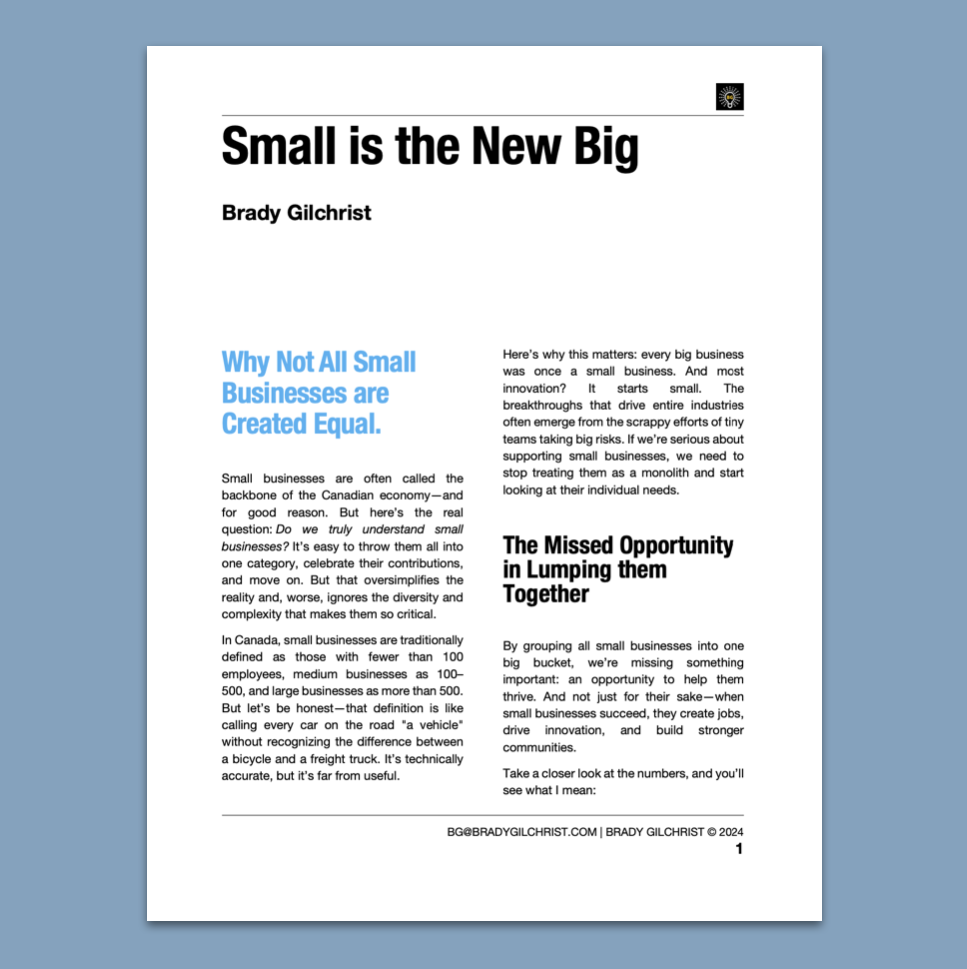The article Small is the New Big by Brady Gilchrist challenges the conventional view of small businesses as a monolithic category and argues for a more nuanced understanding of their diverse needs. While small businesses are often celebrated as the backbone of the Canadian economy, the article highlights how their challenges vary significantly based on size, resources, and structure. Most small businesses in Canada have fewer than 20 employees, yet policies and support systems fail to differentiate between a micro-business with three employees and one with fifty. This oversight results in a missed opportunity to provide targeted assistance, particularly to the smallest businesses, which operate under extreme resource constraints, skill gaps, and time scarcity.
To address this gap, the article advocates for equipping small businesses with the right knowledge, tools, and marketing strategies to help them thrive. It emphasizes that success in marketing doesn’t require big budgets but rather effective, audience-specific approaches that build trust and authenticity. By empowering small enterprises with practical playbooks and solutions, their impact extends beyond their own success, triggering a ripple effect that strengthens the broader economy. The article concludes that supporting the smallest businesses is not just about economic growth—it’s about recognizing their unique potential and fostering innovation from the ground up.
Why Not All Small Businesses are Created Equal.
Small businesses are often called the backbone of the Canadian economy—and for good reason. But here’s the real question: Do we truly understand small businesses? It’s easy to throw them all into one category, celebrate their contributions, and move on. But that oversimplifies the reality and, worse, ignores the diversity and complexity that makes them so critical.
In Canada, small businesses are traditionally defined as those with fewer than 100 employees, medium businesses as 100–500, and large businesses as more than 500. But let’s be honest—that definition is like calling every car on the road “a vehicle” without recognizing the difference between a bicycle and a freight truck. It’s technically accurate, but it’s far from useful.
Here’s why this matters: every big business was once a small business. And most innovation? It starts small. The breakthroughs that drive entire industries often emerge from the scrappy efforts of tiny teams taking big risks. If we’re serious about supporting small businesses, we need to stop treating them as a monolith and start looking at their individual needs.
The Missed Opportunity in Lumping them Together
By grouping all small businesses into one big bucket, we’re missing something important: an opportunity to help them thrive. And not just for their sake—when small businesses succeed, they create jobs, drive innovation, and build stronger communities.
Take a closer look at the numbers, and you’ll see what I mean:
| Size | Number of Businesses | Employees |
| Micro (1–4) | 743,000 | 1,900,000 |
| Small (5–9) | 273,170 | 1,774,000 |
| Small (10–19) | 106,139 | 1,493,000 |
| Subtotal | 1,122,309 | 5,167,000 |
| Small (20–49) | 63,083 | 1,870,000 |
| Small (50–99) | 25,955 | 1,587,000 |
| Subtotal | 89,038 | 3,457,000 |
| Grand Total | 1,211,347 | 8,624,000 |
Now here’s the striking part: most small businesses in Canada have fewer than 20 employees. These businesses don’t just need different support—they demand it. The reality for someone running a company with three employees is worlds apart from someone managing a team of 50. Yet we treat them like they’re the same. That’s not just inaccurate—it’s a missed opportunity and a systematic failure.
Why the Smallest Businesses Are Different
Small businesses—especially the tiniest ones—are a different breed. The people who run them wear every hat imaginable: they’re the CEO, the accountant, the marketing team, and sometimes even the janitor. It’s not just about running a business—it’s about survival.
Here’s what makes their challenges unique:
Resource Constraints: With small budgets and tiny teams, they’re forced to do a lot with very little.
Skill Gaps: They don’t have the luxury of hiring experts for every role. They’re figuring it out as they go.
Time Scarcity: Every day is a balancing act, leaving little room for long-term strategy.
These aren’t just “smaller versions” of big businesses—they’re playing an entirely different game. And if we want to help them succeed, we need to give them tools that fit their reality.
Superpowers for the Smallest Enterprises
This is where the fun begins: giving small businesses superpowers. It’s about teaching them what they don’t know, helping them master it, and handing them playbooks that make implementation seamless.
Here’s how we do it:
- Teach them what they don’t know: The gaps in their knowledge are often their biggest barriers to growth. We help uncover those gaps.
- Show them how to take action: Practical tools and tactics make all the difference. Give them solutions that fit their scale.
- Make it simple and impactful: No fluff. No jargon. Just actionable playbooks that deliver results.
Think of it like giving a small business a toolkit that not only fixes what’s broken but also builds something extraordinary. Because when small businesses thrive, their impact ripples out to the entire economy
Why Marketing is the Linchpin
If there’s one area where small businesses can see immediate returns, it’s marketing. Yet for many, marketing feels like this big, intimidating mystery. They think they need huge budgets or fancy agencies to make it work. But here’s the truth: marketing doesn’t have to be complicated. It just needs to be effective.
For micro-businesses, this means:
Reaching the right people: Forget trying to appeal to everyone. Small businesses thrive when they connect with their ideal audience.
Maximizing impact: Every dollar—and every minute—counts. Simple, cost-effective strategies can go a long way.
Telling their story: Marketing isn’t about shouting louder. It’s about building trust and authenticity.
When we show small businesses how to market effectively, we give them the tools to compete, grow, and create lasting value.
The Trickle-Up Effect
Here’s the part I love most: when you help the smallest businesses, the impact doesn’t stay small. The knowledge, skills, and technologies you introduce to a three-person team have a way of spreading—uplifting larger businesses and strengthening the entire economy.
It’s a ripple effect: empower the smallest enterprises, and you create change that reaches far beyond them.
Small is the New Big
Small businesses aren’t just the backbone of the economy—they’re its beating heart. And like any heart, they need care, attention, and the right support to keep thriving. Yet for too long, we’ve overlooked their diversity and their potential.
It’s time to change that. Let’s stop treating all small businesses the same and start focusing on what makes them unique. Let’s empower the smallest enterprises with tools, knowledge, and superpowers that let them turn challenges into opportunities. Because when the smallest businesses succeed, they remind us of something powerful: small actions can combine to create the biggest waves.
Efficiency Redefined
Remarkable blend of efficiency and flexibility. With just a few clicks, users can access a diverse array of pre-designed block layouts, eliminating the need to start from scratch and significantly reducing development time.
Efficiency Redefined
Remarkable blend of efficiency and flexibility. With just a few clicks, users can access a diverse array of pre-designed block layouts, eliminating the need to start from scratch and significantly reducing development time.
…

